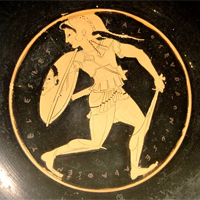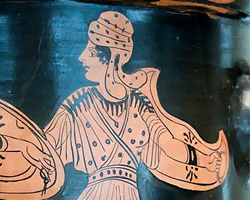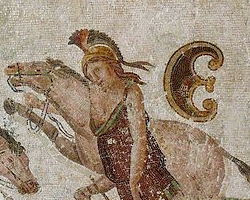
This page created 30 August 2014, and last modified: 20 November 2014 (lightfoot link added)

The Prima Armeniaca is listed (15.26 in Ingo Maier's numbering scheme) as the first of the pseudocomitatenses units under the Magister Militum per Orientem. Its shield pattern (11#7) as shown in various manuscripts, under the matching label (14.g) Prima Armeniaca, is as below:

The shield pattern is simple, having a yellow boss and a yellow main field; surrounding the boss is an unusual design in blue, which looks like a circle with two deep lobes cut out at approximately the 11 o'clock and the 1 o'clock positions. This would appear to be a mythological Amazonian shield.

|

|

|
|
|
|
|
|
|
|
|
As can be seen from the above, Amazons, despite being mythologically located to the north-east, were first conceived by the Greeks as being armed like contemporary Greek warriors; in the 6th century, this meant a heavy Argive shield as depicted above-left. After the Persian invasions, however, Amazons were depicted with light crescent-shaped peltae as carried by the appropriately-located Scythians, although they frequently were shown with a slight "bump" in the middle of the convex section that real peltae did not seem to share, as shown in the middle picture above. This bump seems to have steadily grown, so that by the start of the 3rd century, it could be shown as a central "stalk", as shown above-right, and also corresponding to the motif shown in the Notitia; geographically appropriate for a unit named after Rome's most eastern province.
The shield pattern of Prima Armeniaca is thus very similar to that of the next unit in the Magister Militum per Orientem's list: the Secunda Armeniaca. Two other units in the same command also carry shield patterns featuring this central motif: the Secunda Felix Valentis Thebaeorum and the Prima Flavia Theodosiana; these are both comitatenses legions. Outside of the Magister Militum per Orientem's command, it is carried by only two other units: the Menapii, under the Magister Militum per Thracias, and the unit that is said to be the Sagittarii seniores Orientales, under the Magister Militum Praesentalis II. All six can be compared below, using the patterns taken from the Parisian manuscript:

Whether the Prima Armeniaca was an auxiliary or a legionary pseudocomitatenses unit cannot be determined from its name alone (although it looks legionary), but from Ammianus' history (20.7.1) we learn that Bezabde in 360 was assigned to three legions: Secunda Flavia, Secunda Armeniaca, and Secunda Parthica, plus a large number of archers from the district around Bezabde. Since Ammianus calls II Armeniaca a legion, then so should I Armeniaca be a legion. However, caution must be taken, as Ammianus elsewhere (25.6.3) also calls the Iovii and the Victores, both units of auxilia palatina, "legions". Nonetheless, the grouping of II Armeniaca between what is almost certainly a legion (II Flavia) and what is most certainly a legion (II Parthica) does strongly suggest II Armeniaca was likewise, and thus also Prima Armeniaca. Presumably the unit was named after its original place of deployment, before being incorporated into the field army of the Magister Militum per Orientem.
Inscriptional evidence (in Greek) for the Prima Armeniaca comes from Anemurium (modern Anamar in southern Turkey), where a sea wall was built by soldiers of the "Proton Armenion" - i.e. "First Armenian", see N. Lenski, Assimilation and Revolt in the Territory of Isauria (1999), available here.
The pseudocomitatenses status of Legio I Armeniaca would imply it was a recent addition to the field army; however, a fragment (FGH IV,6) of Eutychianus of Cappadocia, cited (XIII) by the 6th century Byzantine chronicler Malalas, describing Julian's Persian expedition, decsribes (in Greek) an "Arithmou ton Primoarmeniachon" - i.e. "the unit the Primo Armeniaca", as taking part in Julian's invasion of Persia, some 30 years before the earliest date at which the Notitia could have been drawn up. Nonetheless, this in itself is not dispositive, since the Ammianus' inclusion of the Dux Osrhoenae in Julian's expedition implies limitanei units can be called on to join offensive expeditions.

Return to the Notitia alphabetical unit list page.
Return to my Notitia index page.